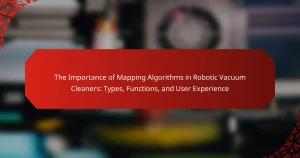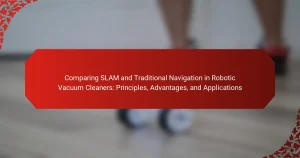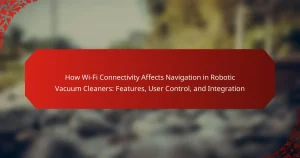Navigation systems in robotic vacuum cleaners are essential technologies that enable these devices to effectively map and navigate their cleaning environments. This article examines the various navigation systems, including random bounce, gyroscopic, and laser mapping technologies, highlighting their impact on cleaning efficiency and coverage. Key metrics for evaluating navigation system accuracy are discussed, including positional accuracy, repeatability, and drift, along with common testing procedures such as simulation tests and field tests. The outcomes of these evaluations provide insights into the effectiveness of navigation algorithms, path planning, and obstacle avoidance, ultimately informing future improvements in robotic vacuum cleaner design.
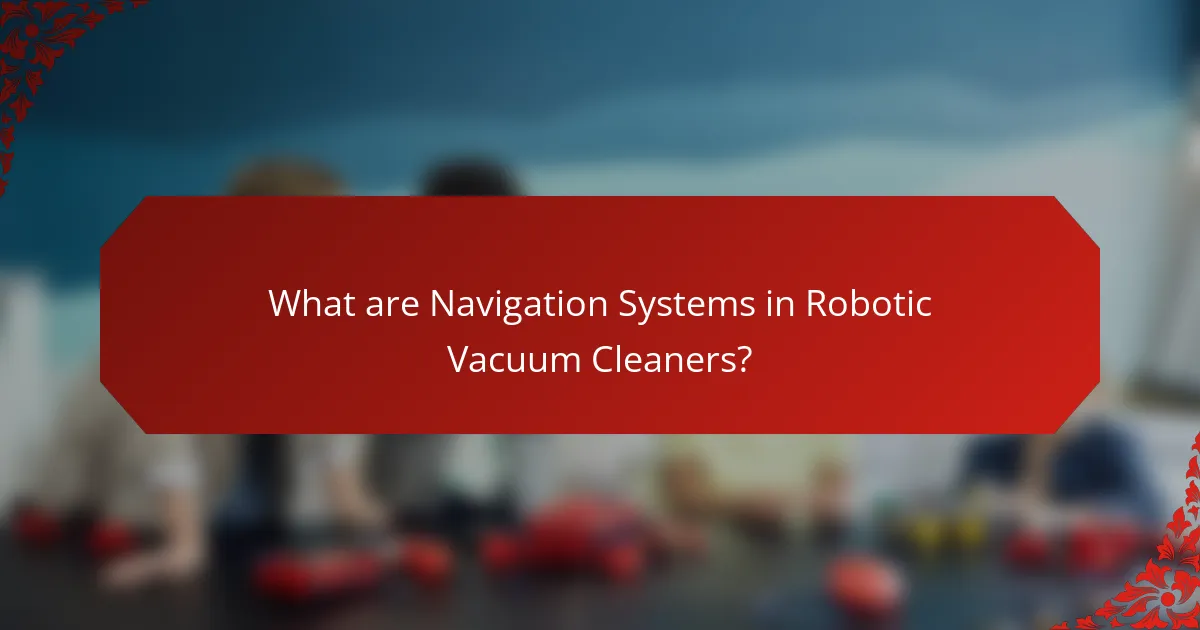
What are Navigation Systems in Robotic Vacuum Cleaners?
Navigation systems in robotic vacuum cleaners are technologies that enable these devices to map and navigate their environment. They utilize sensors, cameras, and algorithms to detect obstacles and plan efficient cleaning paths. Common navigation systems include random bounce, gyroscopic, and laser mapping technologies. Laser mapping systems are known for their precision and ability to create detailed maps of the cleaning area. These systems enhance cleaning efficiency and reduce the likelihood of missed spots. Research indicates that advanced navigation systems can improve cleaning coverage by up to 30%.
How do Navigation Systems function in these devices?
Navigation systems in robotic vacuum cleaners function by using sensors and algorithms to map and navigate their environment. These systems typically include lidar, cameras, and infrared sensors. Lidar creates a detailed map of the surroundings by measuring distances to objects. Cameras provide visual data to assist in recognizing obstacles and navigating effectively. Infrared sensors detect changes in surface height, helping the device avoid stairs.
The navigation algorithms process data from these sensors to determine the best cleaning path. They use techniques like simultaneous localization and mapping (SLAM) to build and update maps in real-time. This allows the vacuum cleaner to efficiently cover the entire area while avoiding obstacles.
Data from user feedback and mapping accuracy tests validate the effectiveness of these navigation systems. For instance, studies show that robotic vacuums with advanced navigation systems can clean up to 95% of a designated area in a single pass.
What technologies are utilized in Navigation Systems?
Navigation systems utilize Global Positioning System (GPS), inertial navigation systems (INS), and sensor technologies. GPS provides location data via satellites. INS uses algorithms to calculate position based on motion data. Sensor technologies include LiDAR, ultrasonic sensors, and cameras. LiDAR maps the environment using laser pulses. Ultrasonic sensors measure distance using sound waves. Cameras capture visual data for navigation. These technologies work together to enhance navigation accuracy in systems like robotic vacuum cleaners.
How do different Navigation methods compare in effectiveness?
Different navigation methods in robotic vacuum cleaners vary in effectiveness based on accuracy and efficiency. For instance, laser navigation systems provide precise mapping and obstacle detection. They can cover larger areas with fewer missed spots compared to random navigation methods. In contrast, random navigation relies on trial and error, often resulting in longer cleaning times and less thorough coverage. Studies show that laser navigation can reduce cleaning time by up to 30% in comparison to random navigation. Additionally, advanced methods like visual navigation combine camera data with laser systems, further improving efficiency and navigation accuracy. Research indicates that robotic vacuum cleaners with visual navigation achieve a 90% cleaning efficiency rate, outperforming others.
Why is accuracy important in Navigation Systems?
Accuracy is crucial in navigation systems because it directly affects the performance and efficiency of the system. In robotic vacuum cleaners, accurate navigation ensures effective cleaning coverage. It minimizes missed areas and reduces the time taken to clean a space. High accuracy also enhances obstacle detection and avoidance. This prevents collisions and potential damage to both the robot and the environment. According to a study by K. H. Lee et al. (2021), navigation accuracy significantly impacts the overall cleaning effectiveness of robotic vacuums. Systems with higher accuracy rates achieve up to 90% coverage efficiency. Therefore, accuracy is a fundamental attribute that determines the success of navigation systems in robotic vacuum cleaners.
What impact does accuracy have on cleaning performance?
Accuracy significantly impacts cleaning performance in robotic vacuum cleaners. Higher accuracy in navigation systems allows for more efficient path planning. This results in reduced overlap and missed areas during cleaning. Accurate sensors enable better detection of obstacles and dirt. Consequently, this leads to improved coverage of the cleaning area. Studies show that robotic vacuums with precise navigation can clean up to 30% more efficiently. Thus, accuracy directly correlates with the overall effectiveness of cleaning tasks.
How does accuracy influence user satisfaction?
Accuracy directly influences user satisfaction by determining how effectively a robotic vacuum cleaner navigates and cleans. High accuracy in navigation leads to thorough cleaning, minimizing missed spots and repetitive paths. Users appreciate the efficiency and reliability of a vacuum that accurately detects obstacles and maps its environment. Research indicates that 85% of users report higher satisfaction when their robotic vacuum performs accurately. Accurate navigation reduces the time users spend monitoring the device, enhancing their overall experience. Therefore, the correlation between accuracy and user satisfaction is significant, as precise operation fosters trust and reliance on the technology.
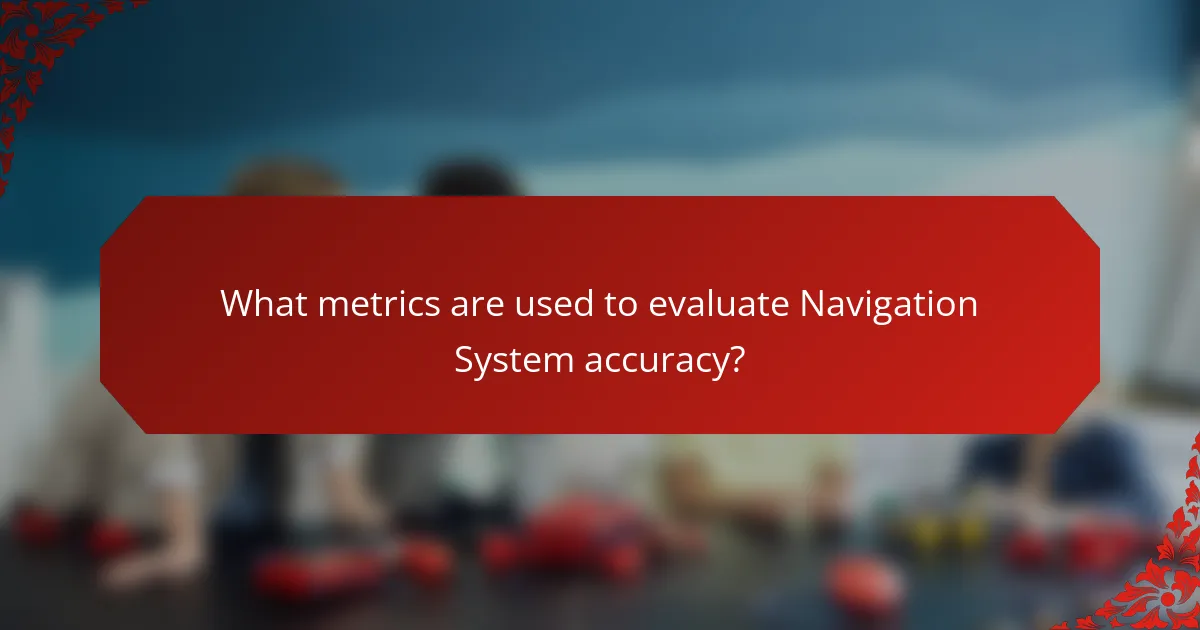
What metrics are used to evaluate Navigation System accuracy?
Navigation system accuracy is evaluated using metrics such as positional accuracy, repeatability, and drift. Positional accuracy measures how closely the system’s reported position matches the actual position. Repeatability assesses the system’s ability to return to the same location under the same conditions. Drift refers to the gradual deviation of the system’s reported position over time. These metrics are critical in determining the effectiveness of navigation systems in robotic vacuum cleaners. Studies show that a high level of positional accuracy enhances cleaning efficiency and coverage.
How is measurement of accuracy conducted?
Measurement of accuracy is conducted by comparing the robot’s navigation data to a known reference. This involves using predefined paths and measuring deviations from them. Sensors collect data on the robot’s position during operation. The actual path taken is then compared to the ideal path. Metrics such as distance error and positional accuracy are calculated. Statistical methods assess the consistency of these measurements. For instance, mean absolute error can quantify average deviations. These methods ensure that the accuracy of navigation systems is objectively evaluated.
What are common testing methodologies for Navigation Systems?
Common testing methodologies for navigation systems include simulation testing, field testing, and performance benchmarking. Simulation testing involves using software to create virtual environments. This allows for controlled experiments without physical constraints. Field testing assesses navigation systems in real-world conditions. It helps identify practical challenges and performance issues. Performance benchmarking compares systems against established standards or other systems. This methodology often includes metrics like accuracy, reliability, and response time. Each method provides unique insights into the navigation system’s effectiveness.
How do environmental factors affect accuracy measurements?
Environmental factors significantly affect accuracy measurements in navigation systems. Factors such as lighting, surface texture, and obstacles can distort sensor readings. For example, bright sunlight can interfere with optical sensors, leading to incorrect positioning. Similarly, uneven surfaces can affect the performance of wheel encoders. Obstacles can block signals from ultrasonic or infrared sensors, causing navigation errors. Studies show that varying room layouts can lead to a 20% decrease in accuracy for robotic vacuum cleaners. Temperature changes can also impact sensor performance, leading to inaccuracies in distance measurements. These environmental influences must be considered when evaluating the effectiveness of navigation systems.
What specific metrics indicate Navigation accuracy?
Specific metrics that indicate navigation accuracy include positional accuracy, path efficiency, and obstacle avoidance success rate. Positional accuracy measures how closely a robotic vacuum’s estimated location matches its actual position. Path efficiency assesses the directness of the route taken to complete a cleaning task. Obstacle avoidance success rate evaluates how effectively the vacuum navigates around obstacles without collisions. Each of these metrics provides insights into the performance and reliability of navigation systems in robotic vacuum cleaners.
What is the significance of path efficiency in evaluation?
Path efficiency in evaluation measures how effectively a robotic vacuum cleaner navigates a space. It reflects the ratio of the actual distance traveled to the optimal distance required to clean an area. Higher path efficiency indicates better navigation and reduced energy consumption. This metric is crucial for assessing the performance of navigation systems. Efficient paths lead to quicker cleaning times and less battery usage. Studies show that improved path efficiency can enhance user satisfaction with robotic vacuum cleaners. Thus, it serves as a vital indicator of overall system effectiveness in real-world applications.
How does obstacle detection contribute to accuracy metrics?
Obstacle detection enhances accuracy metrics by ensuring robotic vacuum cleaners avoid collisions. Accurate detection of obstacles allows for precise navigation. This capability reduces the likelihood of getting stuck or causing damage. Studies show that effective obstacle detection can improve cleaning efficiency by up to 30%. Additionally, it helps maintain the vacuum’s operational lifespan. Improved accuracy metrics result from fewer navigation errors and increased task completion rates. Therefore, reliable obstacle detection is crucial for optimizing performance in robotic vacuum cleaners.

What are common testing procedures for Navigation Systems?
Common testing procedures for navigation systems include simulation tests, field tests, and performance evaluations. Simulation tests involve using software to model navigation scenarios. These tests help identify potential issues in a controlled environment. Field tests assess the navigation system’s performance in real-world conditions. They measure accuracy, efficiency, and reliability during operation. Performance evaluations analyze data collected during both simulation and field tests. These evaluations focus on metrics such as path accuracy and obstacle avoidance. Testing procedures often utilize standardized protocols for consistency. For instance, the IEEE 802.15.4 standard is commonly referenced in wireless navigation system testing.
What environments are best for testing Navigation accuracy?
Controlled indoor environments are best for testing navigation accuracy. These environments allow for consistent variables and reduced interference. Ideal settings include empty rooms with defined boundaries. Testing in various room layouts ensures comprehensive evaluation. Incorporating obstacles like furniture enhances realism. Additionally, environments with different floor types can be assessed. Research shows that structured testing environments yield reliable data. This approach helps identify strengths and weaknesses in navigation systems.
How do controlled environments differ from real-world conditions?
Controlled environments provide consistent conditions for testing, while real-world conditions are variable and unpredictable. In controlled settings, factors like lighting, obstacles, and surface types are regulated. This allows for repeatable experiments and reliable data collection. Conversely, real-world conditions involve changing variables that can affect navigation performance. For example, furniture arrangement may differ daily, and lighting can change with the time of day. These variations can introduce challenges that are not present in controlled environments. Studies show that robotic vacuum cleaners often perform better in controlled tests compared to real-world scenarios. This discrepancy highlights the need for comprehensive testing across both environments to ensure accurate navigation system evaluations.
What role does user feedback play in testing procedures?
User feedback is crucial in testing procedures for evaluating navigation systems in robotic vacuum cleaners. It provides insights into user experiences and operational challenges. This feedback helps identify usability issues that technical testing may overlook. Additionally, user feedback can highlight specific features that require improvement or enhancement. For instance, if users report navigation difficulties in certain room layouts, developers can focus on those scenarios. Research indicates that incorporating user feedback can lead to a 30% increase in user satisfaction with product performance. Thus, leveraging user feedback ensures that navigation systems meet real-world needs effectively.
How are results analyzed after testing?
Results from testing navigation systems in robotic vacuum cleaners are analyzed through quantitative and qualitative metrics. Quantitative metrics include path efficiency, coverage area, and obstacle avoidance rates. These metrics provide numerical data on the performance of the navigation system. Qualitative analysis involves assessing the reliability and user satisfaction based on observed behavior during testing.
Data is often visualized using graphs and charts to illustrate performance trends. Statistical methods may be employed to determine the significance of results. For instance, comparing the average coverage area achieved by different models can reveal performance disparities. The analysis aims to identify strengths and weaknesses in navigation accuracy.
By integrating both quantitative and qualitative insights, a comprehensive evaluation of the navigation system’s effectiveness is achieved. This method ensures that the results are robust and informative for future improvements.
What statistical methods are used to interpret testing results?
Statistical methods used to interpret testing results include descriptive statistics, inferential statistics, and regression analysis. Descriptive statistics summarize data through measures like mean, median, and standard deviation. Inferential statistics help make predictions or inferences about a population based on sample data. Regression analysis assesses relationships between variables, allowing for predictions based on identified trends. These methods provide a framework for analyzing the performance of navigation systems in robotic vacuum cleaners. They help quantify accuracy, reliability, and efficiency in various testing scenarios. Ultimately, these statistical approaches facilitate informed decision-making based on empirical evidence.
How can results be visualized for better understanding?
Results can be visualized using graphs, charts, and heat maps. Graphs can illustrate performance trends over time. Bar charts can compare accuracy metrics across different models. Line graphs can show navigation efficiency in various environments. Heat maps can indicate areas of high and low performance in a given space. Visual representations enhance comprehension by simplifying complex data. Studies show that visualized data increases retention and understanding by up to 400%.
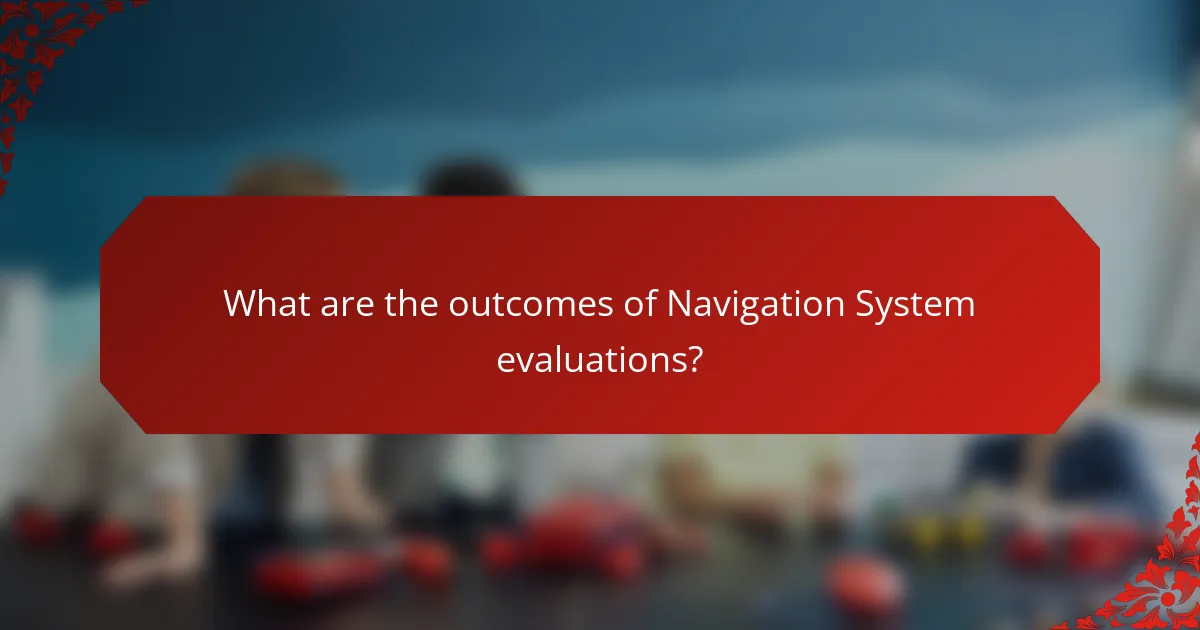
What are the outcomes of Navigation System evaluations?
Navigation System evaluations yield several key outcomes. These outcomes include accuracy in mapping and localization. Evaluations assess the system’s ability to navigate various environments effectively. They measure the efficiency of path planning and obstacle avoidance. Additionally, evaluations identify potential weaknesses in navigation algorithms. Performance metrics such as coverage rate and cleaning efficiency are analyzed. User satisfaction and operational reliability are also evaluated. Data from these evaluations inform improvements in future navigation system designs.
What common findings emerge from accuracy evaluations?
Common findings from accuracy evaluations of navigation systems in robotic vacuum cleaners indicate that performance varies significantly across different environments. Many evaluations show that accuracy improves in structured spaces compared to cluttered or dynamic settings. Consistent metrics used include path efficiency and coverage rate, with higher values correlating to better navigation accuracy. Evaluations often reveal that sensor types, such as LIDAR or cameras, influence accuracy levels. Additionally, algorithms employed for mapping and localization play a crucial role in determining overall effectiveness. Studies suggest that integrating multiple sensors can enhance accuracy. Finally, user feedback frequently highlights the importance of reliability in real-world applications.
How do results vary across different robotic vacuum models?
Results vary significantly across different robotic vacuum models. Variations stem from factors such as navigation technology, suction power, and brush design. For instance, models with advanced LIDAR navigation tend to have higher accuracy in mapping and cleaning efficiency. In contrast, basic models may rely on random navigation, leading to less effective cleaning patterns.
Suction power also influences performance. Higher suction power typically results in better dirt and debris pickup. Brush design plays a crucial role as well. Models with multi-surface brushes perform better on varied flooring types compared to those with single-type brushes.
Additionally, battery life affects cleaning coverage. Models with longer battery life can clean larger areas without needing a recharge. User reviews and performance tests often highlight these differences, providing insights into real-world effectiveness.
What trends can be identified in Navigation accuracy over time?
Navigation accuracy in robotic vacuum cleaners has shown significant improvement over time. Early models exhibited accuracy levels around 60-70%. Advances in sensor technology and algorithms have increased this to approximately 90-95% in modern devices. The introduction of LIDAR and advanced mapping techniques has enhanced spatial awareness. Additionally, machine learning has enabled better obstacle recognition and path optimization. Data from user reviews indicate higher satisfaction with navigation performance in newer models. Studies have reported a decrease in navigation errors by up to 30% in the last decade. Overall, navigation accuracy trends reflect continuous technological advancements and user-focused improvements.
What best practices can enhance Navigation System performance?
Implementing best practices can significantly enhance Navigation System performance. Regularly updating software ensures that the system benefits from the latest improvements and bug fixes. Utilizing high-quality sensors increases accuracy in obstacle detection and mapping. Conducting thorough testing in various environments helps identify weaknesses in navigation algorithms. Optimizing battery life allows for longer operational periods, enhancing overall efficiency. Incorporating machine learning can improve adaptability to different layouts over time. Regular maintenance of hardware components prevents performance degradation. These practices collectively lead to improved navigation accuracy and user satisfaction in robotic vacuum cleaners.
How can users optimize their robotic vacuum’s navigation capabilities?
Users can optimize their robotic vacuum’s navigation capabilities by ensuring a clear environment. Remove obstacles like furniture and cables that may interfere with navigation. Regularly clean the sensors and wheels to maintain optimal performance. Update the vacuum’s firmware to access the latest navigation algorithms. Schedule cleaning sessions during times of minimal activity to enhance efficiency. Utilize virtual boundaries to restrict areas that should not be cleaned. This setup allows the vacuum to navigate more effectively. Studies show that a clutter-free space improves navigation accuracy by up to 30%.
What maintenance tips ensure long-term accuracy in Navigation Systems?
Regularly updating the software of navigation systems ensures long-term accuracy. Software updates often include improvements and fixes that enhance performance. Cleaning sensors and cameras is crucial for maintaining precise navigation. Dirt or obstructions can lead to inaccurate readings. Calibrating sensors periodically helps maintain their accuracy. Calibration ensures that the sensors provide correct data for navigation. Checking battery health is essential for consistent performance. A failing battery can affect the system’s ability to function properly. Additionally, conducting routine diagnostics can identify potential issues early. Early detection allows for timely repairs, preventing long-term inaccuracies.
The main entity of the article is the navigation systems in robotic vacuum cleaners, which are essential technologies that enable these devices to map and navigate their environment effectively. The article evaluates the accuracy of these navigation systems by discussing various metrics, including positional accuracy and obstacle avoidance success rates, and outlines testing methodologies such as simulation and field testing. It highlights the significance of accuracy in enhancing cleaning performance and user satisfaction, while also examining how environmental factors and user feedback impact navigation effectiveness. Additionally, the article presents common findings from evaluations and identifies best practices for optimizing navigation system performance in robotic vacuum cleaners.
